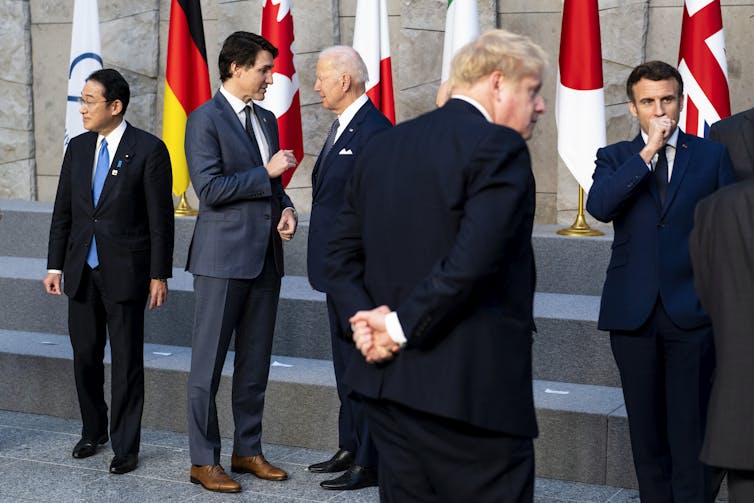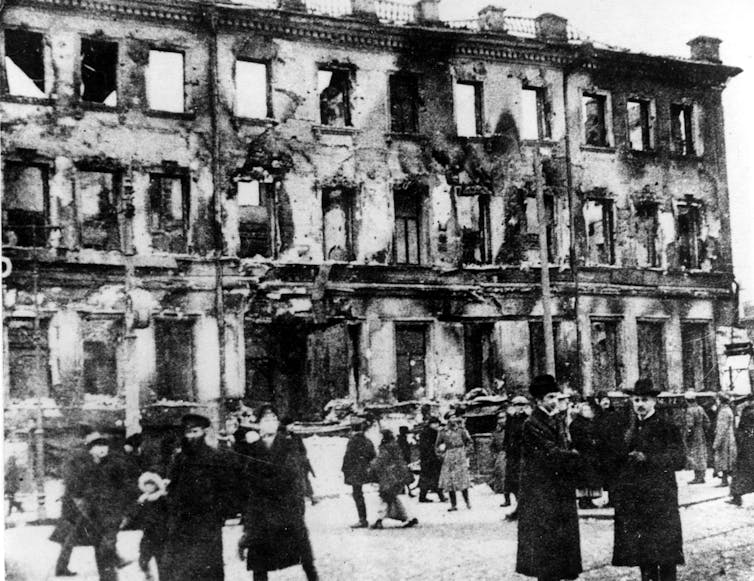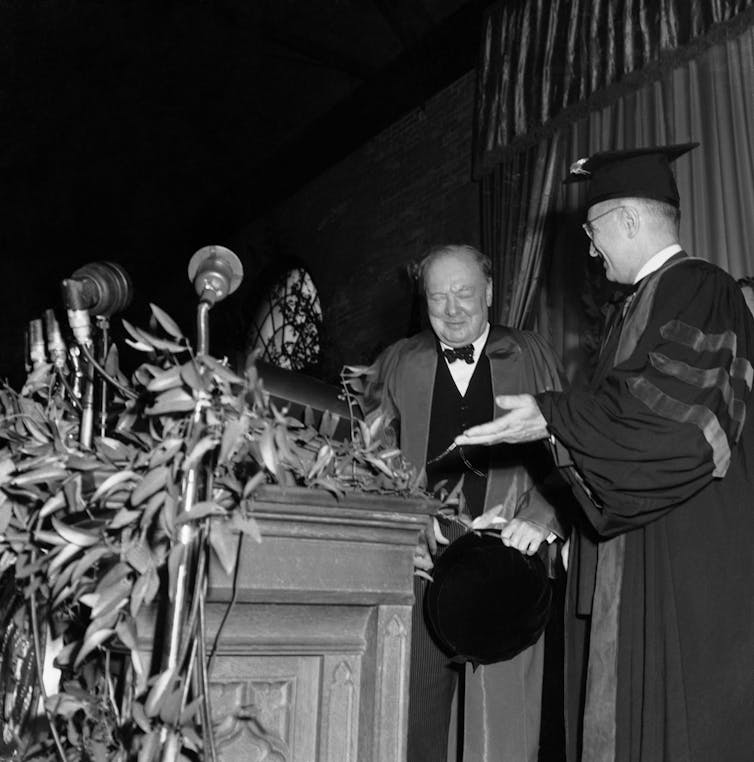Russia is being made a pariah state – just like it and the Soviet Union were for most of the last 10
The West’s new approach to Russia – bar it from international organizations, restrict international trade, prevent further military moves – looks just like how it treated Russia in the 20th century.

The U.S. and its European allies recently said they planned to take a new approach in their relations with Russia: They would isolate and contain the country in the aftermath of its invasion of Ukraine. Doing so would keep Russia out of international organizations, restrict imports and exports, and prevent further military moves, ultimately weakening it.
This treatment of Russia is nothing new for Western countries. While Russia is more economically and politically isolated now than it has ever been, it is no stranger to isolation and containment.
Looking back over the last 100 years, it’s clear that the period between 1992 and 2001, when Russia embraced the West and was largely embraced by it, is the exception. For most of the 20th century and the early 21st century, Russia has been a fearsome power that the West has wanted to hobble.
The West is now returning to a strategy that was effective before in containing Russia.

Russia stands alone – mostly
Following the Russian Revolution in 1917, Russia, as part of the newly formed Soviet Union, found itself isolated from other nations. A revolutionary state that espoused an ideology of worldwide revolution threatened other powers.
That isolation took many forms. The country was not a signatory to the Treaty of Versailles, the most important of several treaties that ended World War I. It was not a member of the League of Nations, the organization founded after World War I to resolve disputes between nations, until 1934. Russia had no foreign trade agreements before 1921 and was not fully recognized in diplomacy by non-Russian powers before 1924.
As a revolutionary pariah state that saw itself encircled by enemies, the Soviet Union hardened its view of the world. While the so-called Grand Alliance of the U.S., Great Britain and Soviet Union found common cause against Nazi Germany during World War II, the relationship was never comfortable. It crumbled swiftly after the war as the three powers focused on their respective spheres of vital interest and expressed differing views for the postwar world.

Containment’s beginnings
After World War II, the U.S. wanted to ensure that democratic governments were established in Europe. The Soviets were intent on establishing communist regimes in Eastern Europe.
To frustrate Russia’s ambitions, what was called “the doctrine of containment” became postwar policy. It was most famously articulated by U.S. diplomat George Kennan in a cable in 1946, later published in Foreign Affairs in 1947.
“It is clear that the main element of any United States policy toward the Soviet Union must be that of a long-term, patient but firm and vigilant containment of Russian expansive tendencies,” wrote Kennan.
“The United States has it in its power to increase enormously the strains under which Soviet policy must operate … to promote tendencies which must eventually find their outlet in either the break-up or the gradual mellowing of Soviet power,” he wrote.
Kennan wrote that the West would not find a way to live with the Soviet Union and that Soviet power could not be controlled by logic or reason, but could be influenced by the logic of force. He argued that political and economic means could be used to contain Soviet power and potentially force it to retreat in its ambitions.
Iron Curtain entrenches
Kennan’s calls for containment of the Soviet Union were followed by concrete actions by the U.S. government.
The Truman Doctrine in 1947 advocated for the U.S. to help rebuild shattered postwar economies in Europe so communism would not become an attractive proposition.
The Marshall Plan implemented this approach and extended economic assistance to postwar Europe. It helped reinvigorate European industry and laid a pathway for European integration. Marshall Plan assistance, which ultimately totaled US$155 billion in current dollars, was offered to all European countries, including the Soviet Union. But the Soviets rejected the offer and forced Eastern European countries under their influence to do the same.
The Soviets answered these Western moves with the creation in 1947 of the Cominform, a Soviet-led bloc of Communist parties aimed at defeating what it saw as U.S.-led Western imperialism and cementing party rule in member countries. Further moves came in 1949 with the creation of the economic organization of Communist countries known as COMECON.
The result was the clear division of Europe into two economic and political spheres, isolating the Soviet bloc from the West. The “Iron Curtain” – the ideological, military and economic divide between democratic Western countries and the Soviet Union, along with the communist countries in its orbit – had solidified.

Containment’s militarization
Concern grew among the Western countries about potential military confrontation with the Soviet Union. That led in 1949 to the formation of the North Atlantic Treaty Organization, or NATO, as part of the move to contain the Soviet Union militarily.
Following NATO’s creation, in 1950 the U.S. State Department proposed a new policy – a top-secret report referred to as “NSC-68” – that emphasized the use of military force over diplomacy in dealing with Soviet power. As the State Department Historian writes:
“Its authors argued that one of the most pressing threats confronting the United States was the ‘hostile design’ of the Soviet Union. The authors concluded that the Soviet threat would soon be greatly augmented by the addition of more weapons, including nuclear weapons, to the Soviet arsenal. They argued that the best course of action was to respond in kind with a massive build-up of the U.S. military and its weaponry.”
More aggressive than Kennan’s ideas of containment, this policy called for a massive buildup of U.S. conventional and nuclear arsenals. Soviet ambition would thus be restricted because its leaders would not likely seek a hot war with the West.
President Harry Truman signed off on NSC-68 in September 1950. It remained U.S. policy until the end of the Cold War in 1991.
Containment’s effects
By the early 1950s, The Soviet Union was isolated and contained by economic, political and military means in Europe. Yet Soviet leaders sought to consolidate and maintain power over Eastern Europe, using force at times. The Soviets also exercised cautious ambitions in other regions, provoking Western fears of a spread of Soviet power to the Far East, the developing world and Latin America.
The U.S. and its partners worked to isolate Soviet power beyond Europe with the creation of the Southeast Asia Treaty Organization in 1954 and through attempts to support noncommunist regimes in Latin America, Asia, the Middle East and the developing world during the ensuing decades.
[Understand key political developments, each week. Subscribe to The Conversation’s politics newsletter.]
The effects of the isolation of the Soviet Union during the Cold War era became clear as Soviet and Eastern Bloc economies lagged behind those of the West, particularly in the production of consumer goods, as early as the 1950s. The democratic freedoms of the West were largely absent.
Isolation also led to the Soviet closed state, with propaganda, the stifling of dissent, censorship, a state-controlled media, suspicion of foreigners and a society that was intended to be impervious to foreign influence.
Additionally, the West’s militarized containment of the Soviet Union drove a costly arms race, both nuclear and conventional, which had damaging effects on the Soviet economy by the late 1970s. That contributed to other societal challenges to Soviet power, such as rising nationalism and disillusionment with the Soviet project, which became clear in the 1980s as Soviet society faced food and consumer good shortagesand dissent rose. All served as contributing factors to the fall of the Soviet Union in 1991.
In 2022, the West is responding to Russian aggression as it has done so before – through implementing policies of isolation and containment to curb and weaken Russian power.
Alastair Kocho-Williams does not work for, consult, own shares in or receive funding from any company or organization that would benefit from this article, and has disclosed no relevant affiliations beyond their academic appointment.
Read These Next
As DOJ begins to release Epstein files, his many victims deserve more attention than the powerful me
Powerful men connected to Jeffrey Epstein are named, dissected and speculated about. The survivors,…
The world risks forgetting one of humanity’s greatest triumphs as polio nears global eradication − 7
Polio may finally be defeated in the next 5 years. Will the world recognize what an extraordinary achievement…
People are getting their news from AI – and it’s altering their views
Even when information is factually accurate, how it’s presented can introduce subtle biases. As large…





